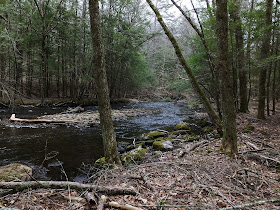There has been a lot of misunderstanding about this program, why it ended, what the state of CT has done since, and why Atlantic salmon won't be coming back any time soon. There is an awful lot of ignorance about fisheries in the general public and even in the fishing community, as was evidenced by the brief excitement in 2014 when salmon redds were documented in the Farmington. A lot of people that knew I fished brought it up to me ."Did you hear about this? Maybe they're coming back after all!" Meanwhile, fisheries biologists and those who had a decent understanding of what the situation looked at the same information and just shrugged. It was interesting, but it was not a good sign. Some of the last salmon from the huge federal stockings returned that year, and because the hatcheries had already been closed, these salmon were allowed to proceed up river through the fish ladder at Rainbow Dam. Every year during the duration of the program fish were trapped in the fish way, trucked to a hatchery, and spawned under controlled conditions, thus skipping much of the mortality that would occur with the adults in the river during the summer, during spawning, and in the first weeks of the juvenile salmon's life. The offspring of these fish would then be stocked into the appointed rivers. So salmon spawning in CT was not a good sign of things to come, but a symptom of their eventual death.
CT is the last state doing anything at all with Connecticut River Salmon, and it isn't a restoration program. It is what's being called a "Legacy Program". Basically, we are trying to maintain a little bit of the genetic stock while producing some limited fry and surplus broodstock for stocking. It won't result in a viable population, but it is something. Almost certainly a hopeless something, but even a hopeless something is better than nothing.
Last week I helped a crew volunteers and seasonal employees lead by CT DEEP Fisheries biologist Bruce Williams stock unfed salmon fry in two Connecticut River tributaries. The odds that even one or two of the fish we released comes back in 4 years is are nearly zero, but what we were doing was not without its benefits. These little fry will a fraction of the biomass that is missing from these streams without the natural presence of salmon reproduction. These little fish will act as a food source for numerous organisms between here and the North Atlantic, from wild brook trout and striped bass to macroinvertabrates and microbes to birds and mammals. It isn't much but it's something. It is nearly impossible for humans to replace what we have destroyed, but trying is a lot better than mindlessly going about the destruction and pretending we aren't doing anything wrong. So I carried my bucket of tiny fish for a mile, distributing them in the best possible habitat and keeping them as happy and healthy as possible, all the while knowing that if this needed entirely to be about getting wild salmon back it would be an exercise in futility but as a way of making this habitat just a little bit more natural, it was a service to the stream.
 |
| The result. |
The first is to stop eating them. Farmed, wild, it doesn't matter. There is no sustainable way to maintain Atlantic salmon as a commercial food product at this time.
Another way is to help raise awareness. If you yourself are not informed well enough, you can still help those who are get their message out. A friend of mine, Brandon, has written a children's book about Atlantic salmon with illustrations by a student of his. He wants to be able to publish at least 200 hard copies. Please consider donating here: www.gofundme.com
Not only will the book itself inform children on Atlantic salmon, but a portion of the proceeds will go towards salmon conservation.
These are spectacular fish. The hope may be gone for the Connecticut River, but we shouldn't let them disappear from the rest of their range.





Well done Rowan! Conserve and promote can only mean positive outcomes.
ReplyDeleteTie, fish, write, conserve and photo on...
Thank you.
DeleteThanks for writing this.
ReplyDeleteMy father fished for salmon on the Tusket River in Nova Scotia--before World War II. I still have the huge heavy bamboo rod he bought up there as a kid for fishing them.
Of course hydroelectricity destroyed them.
And the Bluefin stopped coming to Tusket Rip too. Gee I wonder why...
Good point about the eating *farmned* salmon being bad too! Looking at the Norwegian and the Scottish problems, I shudder. Seems like only Ireland has a healthy unsullied population in Europe now.
Kola is more unsullied that Ireland in my opinion.
DeleteI did some volunteer salmon frye stocking with Bruce W. and Tim W. some 13 years ago, probably the same streams you just stocked. Good memories.
ReplyDeleteHiking 2 miles with a bucket full of tiny fish, trying desperately to keep them alive and stock them in the right places... a lot more enjoyable than it sounds.
DeleteI found something on youtube.
ReplyDeleteApparently Ted Williams fished for salmon...
https://www.youtube.com/watch?v=U7MiPagrXzA
He fished for more than Salmon. He fly fished enough that there was a reel that takes his name. I have one.
Delete